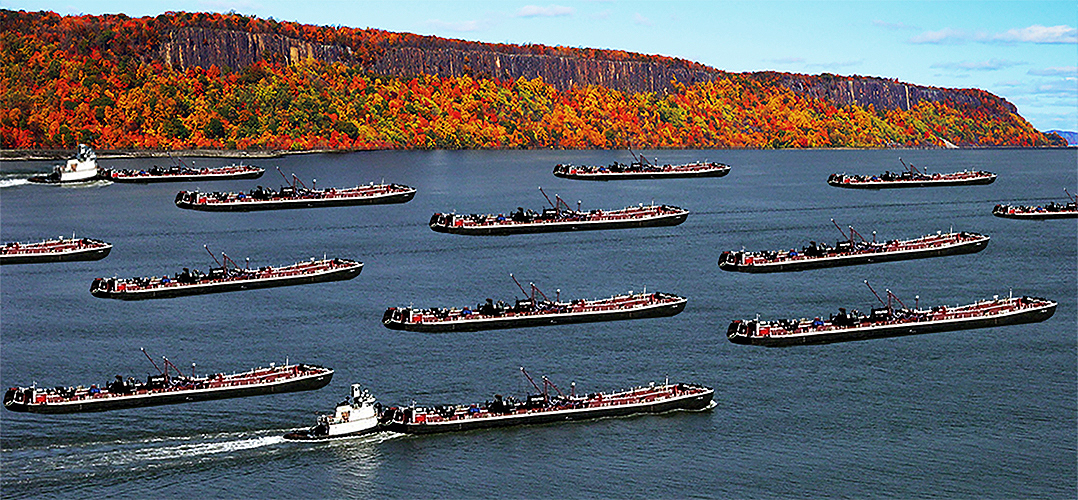Pace Clinic’s finding of agency error confirmed by Coast Guard action.

A version of this article first appeared in the Journal News of August 6, 2017.
In a stunning about-face on June 28, the U.S. Coast Guard announced it will “suspend future rulemaking decisions” regarding 43 “special anchorages” for oil barges on the Hudson River while it conducts a Port and Waterways Safety Assessment (PAWSA), a study of river navigation issues. However, as Coast Guard Commandant Paul F. Zukunft was warned more than seven months ago, that study and much more are required to ensure protection of the Hudson Valley, according to the Environmental Policy Clinic of Pace University’s Dyson College.
On December 5, Pace Clinic students wrote Admiral Zukunft requesting he withdraw the proposed anchorage plan because his agency had not complied with its procedural manual, Waterways Management: Anchorage Management Tactics, Techniques, and Procedures, which requires a PAWSA, public outreach, informational meetings and more. “There is no evidence that the Coast Guard has conducted a PAWSA study for the sections of the Hudson River where the special anchorages have been proposed,” the Clinic wrote.
New York State Senators Terrence Murphy, Sue Serino and David Carlucci, and Westchester County Executive Rob Astorino endorsed the Pace Clinic letter at a riverfront news conference. Mr. Astorino said, “How embarrassing is it that it took students from Pace University to shame, expose, and embarrass the federal government on a situation like this?” The Coast Guard publicly denied the Clinic’s allegations, then, in June, reversed itself.

Student clinician Christina Thomas addresses the media, with state Senators Terrence Murphy and David Carlucci, and Westchester County Executive Rob Asterino.
x
Had the Coast Guard conducted the PAWSA in the first place, it could have saved the public considerable time, expense and worry. The tug and barge industry allegation that special anchorages would address an unproven surge in safety problems was suspect at best. More likely, the anchorages were intended as 43 parking spaces for Bakken oil. But the Coast Guard published the industry claim as its own in the Federal Register, refused public and media requests for more information, and declined repeated invitations to participate in public meetings, such as those convened by Senator Murphy.
The Coast Guard decision to stonewall the public, forego the PAWSA and disregard its procedural manual demands an inquiry by the Inspector General of the Department of Homeland Security, which houses the Coast Guard. In the meantime, the Coast Guard should immediately appoint an advisory panel of Hudson Valley stakeholders as one step toward assuring transparency and accuracy in the upcoming PAWSA.
The Pace Clinic’s investigation further revealed that the Coast Guard had exempted itself from the requirements of the National Environmental Policy Act.
Of equal concern is whether the Coast Guard will conduct an environmental review once it proposes a new special anchorage plan. More than 10,000 public comments were filed about the original plan, the overwhelming majority negative because of the Coast Guard’s failure to consider potential impacts, such as oil spills and threats to tourism. The Pace Clinic’s investigation further revealed that the Coast Guard had exempted itself from the federal environmental impact statement process by claiming a “categorical exclusion” from the requirements of the National Environmental Policy Act (NEPA).
An environmental impact statement would provide what the Coast Guard did not: a determination of need; an evaluation of impacts, including environmental, economic, aesthetic, recreational and historic; and an analysis of alternatives, including the alternative of no anchorages. The Coast Guard would be required to issue draft findings and solicit public comments. A public hearing would be a certainty. The agency would then publish a final impact statement that includes responses to the public’s comments. Importantly, failure by the Coast Guard to follow NEPA rules would be grounds for a court challenge.
Last February 4, Pace Clinic students Christina Thomas and Rowan Lanning proposed an amendment to the annual Coast Guard authorization bill that would designate any proposal for Hudson River special anchorages a “major federal action” under NEPA, thereby requiring an environmental impact statement. They have submitted their proposal to New York Congressman Jerrold Nadler, who sits on the House committee with Coast Guard jurisdiction. In the coming week, the students will distribute it to the full Hudson River congressional delegation.
To regain the public trust squandered by the anchorage fiasco, the Inspector General, Coast Guard and Congress must do their respective parts to guarantee the public substantive participation, transparent rulemaking, an independent evaluation of need, and a formal environmental impact process. The Hudson River Valley, its ecosystem and its communities deserve nothing less.
